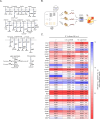Strain-specific galactose utilization by commensal E. coli mitigates Salmonella establishment in the gut
- PMID: 40577327
- PMCID: PMC12204579
- DOI: 10.1371/journal.ppat.1013232
Strain-specific galactose utilization by commensal E. coli mitigates Salmonella establishment in the gut
Abstract
Salmonella enterica serovar Typhimurium (S. Tm) is a major cause of gastrointestinal diseases worldwide. To date, options for prevention or curative therapy remain limited. The gut microbiota plays a protective role against enteric diseases, particularly in preventing establishment and proliferation of S. Tm. While most research has focused on microbiota-mediated pathogen exclusion during the later, inflammation-dominated stages of infection, little is known about how microbiota members mitigate S. Tm early gut colonization. To address this gap, we conducted 24 h in vivo competitive experiments using S. Tm and different commensal E. coli strains. We observed a significant reduction in pathogen load, which was strain-specific and particularly evident with E. coli 8178. To investigate the underlying molecular mechanisms, we performed an in vivo screen using a rationally designed S. Tm library-which includes a wide range of carbohydrate utilization mutants-both in the absence and presence of E. coli strains. Our findings revealed that E. coli 8178-mediated S. Tm competition was driven by the exploitation of galactose during the early stage of infection. Identifying galactose as a key metabolite in pathogen exclusion by gut microbiota members enhances our mechanistic understanding of microbiota-mediated protection and opens new avenues for developing microbiota- and dietary-based strategies to better control intestinal infections.
Copyright: © 2025 Schubert et al. This is an open access article distributed under the terms of the Creative Commons Attribution License, which permits unrestricted use, distribution, and reproduction in any medium, provided the original author and source are credited.
Conflict of interest statement
The authors have declared that no competing interests exist.
Figures



Similar articles
-
Gut microbiota carbon and sulfur metabolisms support Salmonella infections.ISME J. 2024 Jan 8;18(1):wrae187. doi: 10.1093/ismejo/wrae187. ISME J. 2024. PMID: 39404095 Free PMC article.
-
A Simple In Vitro Gut Model for Studying the Interaction between Escherichia coli and the Intestinal Commensal Microbiota in Cecal Mucus.Appl Environ Microbiol. 2018 Nov 30;84(24):e02166-18. doi: 10.1128/AEM.02166-18. Print 2018 Dec 15. Appl Environ Microbiol. 2018. PMID: 30291119 Free PMC article.
-
Distinct adaptation and epidemiological success of different genotypes within Salmonella enterica serovar Dublin.Elife. 2025 Jun 25;13:RP102253. doi: 10.7554/eLife.102253. Elife. 2025. PMID: 40560760 Free PMC article.
-
Signs and symptoms to determine if a patient presenting in primary care or hospital outpatient settings has COVID-19.Cochrane Database Syst Rev. 2022 May 20;5(5):CD013665. doi: 10.1002/14651858.CD013665.pub3. Cochrane Database Syst Rev. 2022. PMID: 35593186 Free PMC article.
-
Sun protection for preventing basal cell and squamous cell skin cancers.Cochrane Database Syst Rev. 2016 Jul 25;7(7):CD011161. doi: 10.1002/14651858.CD011161.pub2. Cochrane Database Syst Rev. 2016. PMID: 27455163 Free PMC article.
References
-
- WHO U. WHO estimates of the global burden of foodborne diseases: foodborne diseases burden epidemiology reference group 2007-2015. World Health Organization; Geneva, Switzerland: 2015.
MeSH terms
Substances
LinkOut - more resources
Full Text Sources
Medical
Miscellaneous

